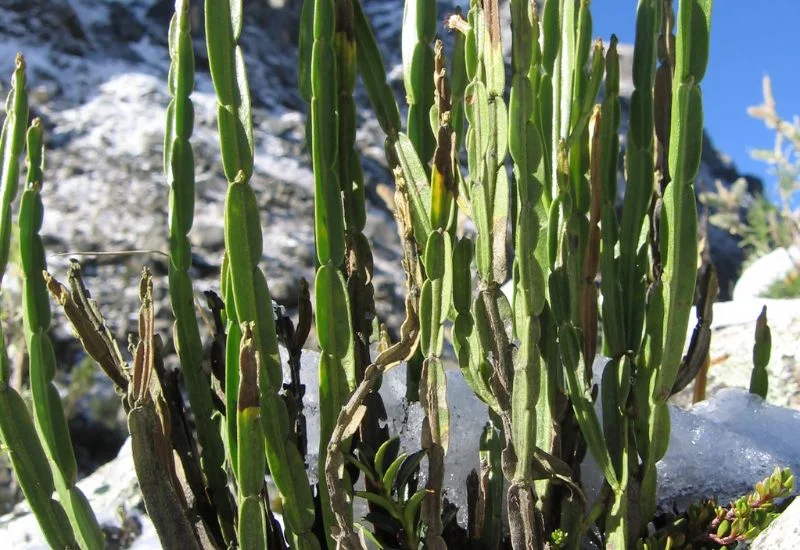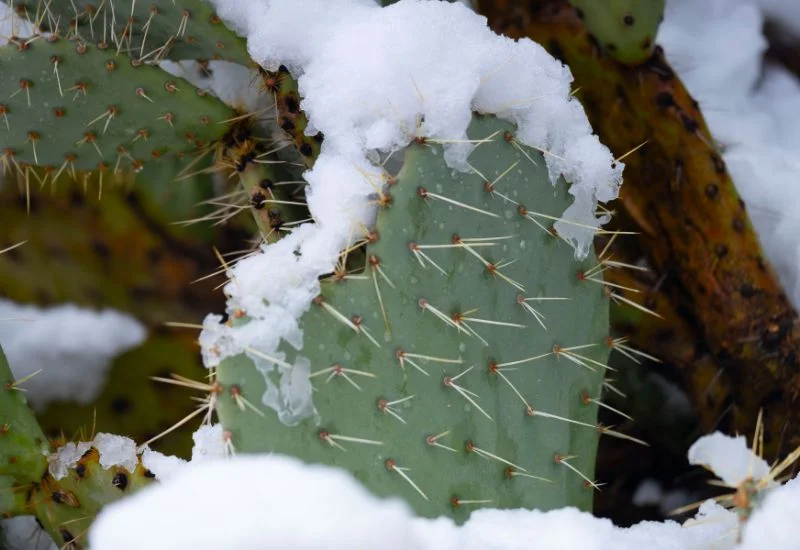In cold areas, many people want to plant cactus in their gardens. However, they are unsure about the correct way to grow cacti at low temperatures. Some people try, but it results in the death of their cactus.
However, it is possible to grow cacti in cold areas. You need to manage the proper environmental conditions. Moreover, you can select the cactus species that can survive in chilly climates.
In the following blog post, you will read a comprehensive discussion about the survival of cacti in the cold. At the same time, you will read about some cold, hardy cactus species and their characteristics.
Let’s begin this discussion!
Interesting Facts about Cactus

The cactus is basically a plant in a hot climate. It has all the features that help it to survive in high temperatures. Moreover, their succulent features enable them to survive with a minimal quantity of water. Here are some main features of cactus that make it a plant of warm deserts:
- Leaves are modified into the spines. These reduce the evaporation of water from the plant.
- The roots of the cactus grow shallow and spread wide growth. Both of these features absorb the rainwater and store it for the future.
- The thick stem of the cactus also helps to store water.
- The waxy surface and deep surface stomata reduce water loss through evaporation and transpiration.
All these features make the cactus an ideal plant for a warm environment. However, there are some cold, hardy species of cacti that can survive in cold. These species have naturally formed some features to adapt to the cold winters, high altitude, and temperature fluctuations.
Cactus Species that can Live in Cold
Several cactus species have adopted the cold weather, such as the following:
- Ball Cactus
- Prickly Pear Cactus
- Hedgehog Cactus
- Coryphantha
The above-mentioned species can survive even at -34°C. However, make sure it is for a short period of time, as prolonged low temperatures can cause the death of your cactus.
Features of Cold Hardy Cactus
Cold, hardy cacti have developed several features that helped them to survive the harsh conditions of winter. Here are some of the most important features:
- One of the main features is their tissue’s dehydration ability. They remove the stored water from their tissues. In this way, water will not freeze in them, and they will not be damaged by frost.
- The waxy covering will provide insulation against external conditions. At the same time, it will avoid the moisture loss in the dry environments.
- The dense spines around the cactus will act like hair to create a warm air layer around the cactus. In this way, it will remain protected from the external temperature fluctuations.
- Cacti also release anti-freezing chemicals, such as soluble sugars and protein. Due to such chemicals, plants will not form ice in them.
Moreover, cacti reduce their metabolism or go into a dormant phase. In this way, they do not consume energy, and they can survive the cold temperature. At the same time, due to their compact structure, ice easily accumulates on them. This also works as an insulating layer around the plant.
How to Grow Cactus in Cold Environment?

Select the Cold Hardy Cactus
First of all, you have to select the cactus that is suitable for the environment in which you are going to plant it. For this purpose, you have to consider the following factors:
- The hardness zone in which this cactus naturally grows. Usually, cold, hardy cacti are found in hardness zones between 3 to 9. So, you have to select the cactus that matches your area’s hardness zone.
- The humidity level or moisture level of your area also matters, as some cactus have sensitive roots. They can form root rot when exposed to water. This water can be in the form of moisture in the air, rainwater, and snow water.
- Another factor to consider is the shape of the cactus. If you want to grow cactus in a cold environment, you should select the compact and spiny species of cactus.
Considering all these factors, the best cactus species for cold environments are Opuntia, Escorbaria, and Echinocereus.
Plant in Ideal Soil Mixture

After selecting any cactus from the above-mentioned species, you have to prepare the soil mixture. This soil mixture should mimic the soil of the natural environment of cacti. You can buy the soil mixture for your cactus or can prepare it yourself. If you want to prepare it, you can follow the below-given steps:
- First of all, you have to collect the main ingredients, which include the potting soil with organic matter, horticultural sand, gravel, and perlite or compost.
- Now, mix each ingredient. However, make sure that the mixture has sand of about 50% of the total soil mixture, 40% of potting soil, and 10% of compost or perlite.
- You have to adjust the soil mixture according to the climatic conditions of your area. If it is a rainy area, add more sand and perlite. For dry climatic conditions, the mixture should have more organic matter.
A layer of gravel or small stones should be added to the soil. It is necessary in cold areas where there is snowfall.
Water in Small Quantity
Cactus is naturally adapted to low-water conditions. So you don’t have to worry about the watering. Especially in the winter season, you can stop watering for the whole season. In this season, metabolism in the cactus slows down. The entire cactus stem shrinks and wilts to a great extent. This is actually the hibernate state of cactus. During hibernation, watering can kill your cactus.
In summer, it is recommended to wait for the rain to water your cactus. However, if dry days prolong and the surface becomes so dry. You can water in small quantities. The best way to water is to distribute water on the complete soil, not only on the plant.
Protect from Harsh Conditions

Cactus can survive harsh conditions, such as high temperatures, low water conditions, bright sunlight, etc. However, if you are keeping it at your home, you should protect it from heavy rains, harsh winds, and ice. You can do this by covering it with a burlap or using a canvas tent over it.
Position of Cactus Pot
You have to place the cactus pot in a place where it can get at least 6 hours of bright direct sunlight. For indoors, you have to place the pot in front of south or east-facing windows. However, you have to choose a room that has no air conditioners and heaters.
Conclusion
If you want to grow a cactus in a cold environment, you should research the desired species of cactus properly. Moreover, you have first to set proper conditions and then bring that cactus. Moreover, you have to learn about the potential diseases of the cactus so that you can provide them with suitable treatment.
